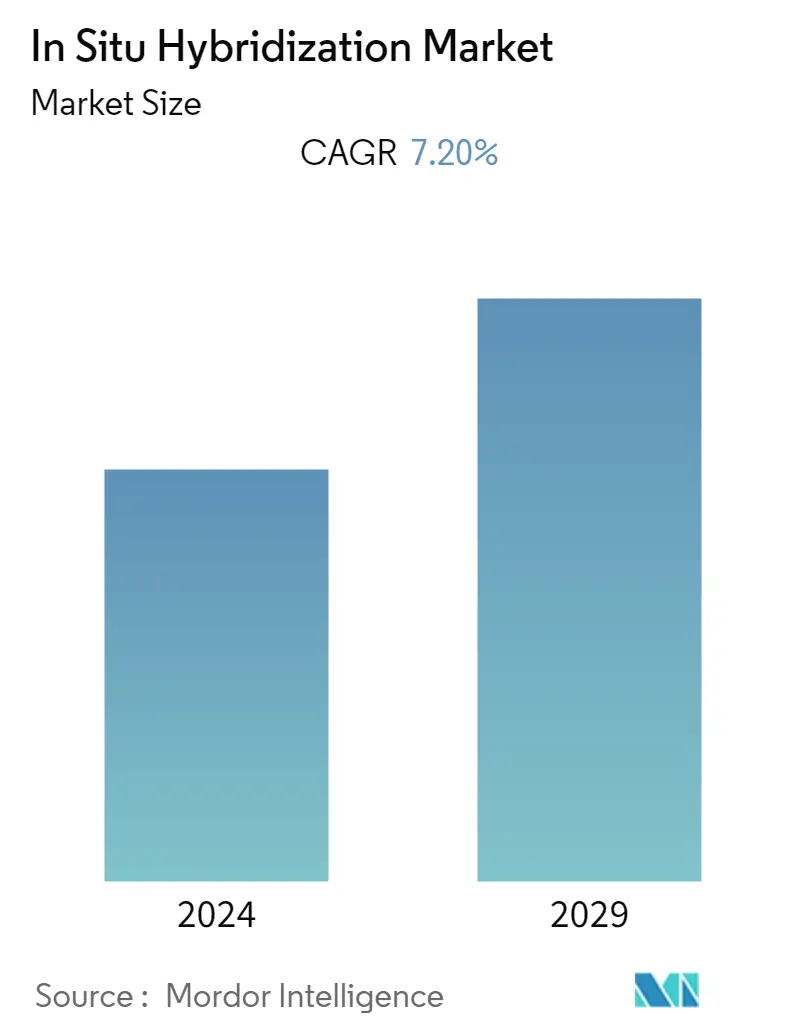Market Size of In Situ Hybridization Industry

| Study Period | 2021 - 2029 |
| Base Year For Estimation | 2023 |
| Forecast Data Period | 2024 - 2029 |
| CAGR | 7.20 % |
| Fastest Growing Market | Asia Pacific |
| Largest Market | North America |
Major Players
*Disclaimer: Major Players sorted in no particular order |
Need a report that reflects how COVID-19 has impacted this market and its growth?
In-Situ Hybridization Market Analysis
The In Situ Hybridization Market studied is expected to register with an anticipated CAGR of 7.2% during the forecast period.
The COVID-19 pandemic is expected to have a significant effect on the market. To keep pace with increased testing norms to detect suspected cases of COVID-19, with the emergence of the SARS-CoV-2 virus, already increased lab testing demand grew even more across the world. For instance, the article published in Nature Journal in October 2021 mentioned that a rapid fluorescence in situ hybridization protocol capable of detecting SARS-CoV-2 specifically and quantitatively in approximately 20 minutes in virus cultures combined nasal and throat swabs with added virus and likely patient samples with added virus and likely patient samples without previous purifications. Such proven efficacy of in situ hybridizations in the diagnosis of COVID-19 infection significantly impacted the market growth during the pandemic period. Also, the demand for in situ hybridization is expected to remain intact due to the emergence of various mutant strains of the SARS-CoV-2 virus during the post-pandemic period, thereby driving the growth of the market during the forecast period.
The increasing incidence of cancer, infectious diseases, and genetic disorders and the growing awareness of cancer therapeutics are the major drivers for the growth of the in-situ hybridization market. For instance, the Global Flu data published in February 2022 mentioned that an estimated 1 billion people worldwide are infected by seasonal influenza yearly. The report also mentioned that out of those 1 billion, about 3 to 5 million people have a severe case of flu every year. Likewise, the report published by the World Health Organization in November 2021 reported that more than 1.0 million sexually transmitted infections are acquired globally, and most of them are asymptomatic. It also reported that every year there are an estimated 374.0 million new infections, with 1 out of 4 sexually transmitted infections: gonorrhea, chlamydia, trichomoniasis, and syphilis.
Additionally, as per the WHO factsheet published in February 2022, in 2021, there were an estimated 1.9 million new cancer cases diagnosed in the United States. The report also mentioned that each year, approximately 400,000 children develop cancer globally. Cervical cancer is the most common in 23 countries, such as Eswatini, India, South Africa, Latin America, and others. The most common cancers are breast, lung, colon, rectum, and prostate. Such rising cases of infectious diseases and cancer across the world are expected to drive the demand for advanced and effective diagnosis, thereby contributing to the growth of the market over the forecast period.
Additionally, the rising market players' initiatives, such as partnerships, acquisitions, and mergers to develop in situ hybridization techniques, are also expected to propel the market's growth. For instance, in March 2021, Bio SB announced that through its partnership agreement with ZytoVision, it would distribute a line of CE-approved chromogenic in situ hybridization and fluorescent in situ hybridization probes targeted for use in lung carcinomas.
However, the lack of skilled professionals to perform advanced procedures is expected to restrain the market's growth over the forecast period.
